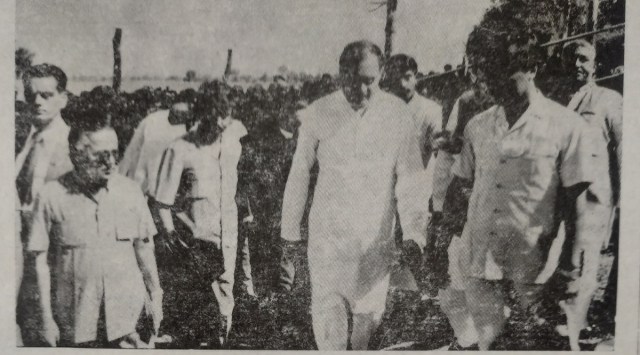The Swan swells again, but now has channels to guide its flow
Satpal Singh Satti claims the channelisation project to be one of a kind. Deputy Commissioner Raghav Sharma seconds him: "Elsewhere, we hear of interlinking of rivers, but not channelisation."
 During the then PM Rajiv Gandhi’s visit to the district in 1988. (Photo courtesy Giriraj)
During the then PM Rajiv Gandhi’s visit to the district in 1988. (Photo courtesy Giriraj) Comrade Jagat Ram Sharma, 82, from Dehlan village, still remembers the havoc wreaked by Swan river on Una district in 1988.
“It rained heavily at that time, though we don’t remember the rainfall in mm measurement. There was widespread devastation. Thankfully, this time, there was more rain but less damage.”
Satpal Singh Satti, the sitting BJP MLA from Una, says the flood aftermath was so bad at that time that the then prime minister Rajiv Gandhi made a dash to the district to assess the ground situation.
Dr S K Nanda, 72, explains the difference between 2023 and 1988. “If there was less damage due to rain in Una district this time, it was mainly due to channelisation of Swan river.”
Indeed, much water has flown down the Swan, which has 73 tributaries, in this span of 35 years. Once known as a river of sorrow, the Swan has a total length of 80 km, out of which 60 km falls in Himachal Pradesh. Its total catchment area is about 1,400 square km, out of which 1,200 square km falls in Una district. The remaining part of its catchment area is in Punjab where it joins Sutlej river.
Year after year, the sullen and swollen Swan river during monsoon caused widespread devastation — until the channelisation happened. The channelisation refers to river channel engineering undertaken for the purpose of flood control.
Satti claims the channelisation project to be one of a kind. Deputy Commissioner Raghav Sharma seconds him: “Elsewhere, we hear of interlinking of rivers, but not channelisation.”
The Swan channelisation has been executed in three phases — Phase I from Daulatpur bridge to Gagret bridge; Phase II from Gagret bridge to Jhalera bridge; and Phase III from Jhalera bridge to Punjab boundary — at a cost of Rs 301.39 crore in 14 years (from 2000 to 2013). The channelisation of Swan tributaries has been completed in a single phase — Phase IV — at a cost of Rs 907.68 crore in nine years (from 2013 to 2021). The total cost of the channelisation project has been Rs 1209.08 crore. The river has been channelised only in Una district while it goes up to Ropar in Punjab.
When 197.7 mm rainfall was recorded on July 9 this year, the district administration sprang into action. To get a clear picture of waterlogging in the district, it conducted a drone survey. An acute problem of waterlogging was spotted at Sanoli, Majara, Beenewal and Malukpur, the four villages situated on the Swan floodplains.
“To rectify the drainage system of these four villages, we have made a proposal of Rs 67 crore and sent to the Centre,” says DC Sharma. “Mercifully, no major damage was caused by Swan this time.”
Of course, the Swan is on course now. It does not break hearths and hearts anymore.








